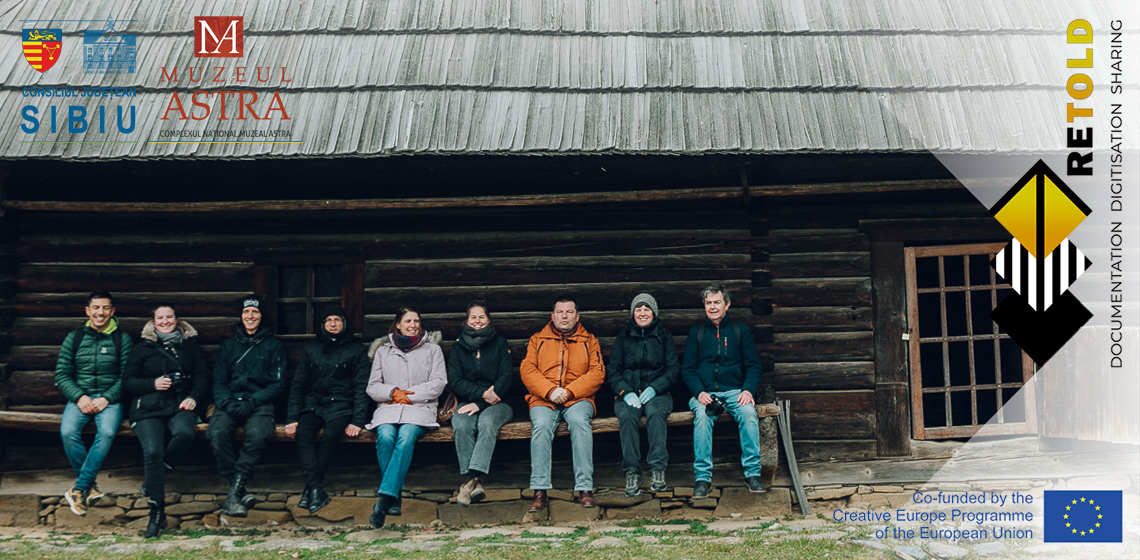The content is published under a Creative Commons Attribution Non-Commercial 4.0 License.
Unreviewed Mixed Matters Article:
RETOLD: Review of the Meeting at ASTRA, Sibiu, March 2023

At the end of March 2023 the second face-to-face meeting of the partners from the RETOLD Project was organised in Sibiu. The host was the ASTRA National Museum Complex. The meeting took place in the Open-Air Museum of Dumbrava Sibiului, one of the largest open air museums in Europe that comprises over 400 traditional dwellings that have been transferred from all over Romania, ranging from technical installations like wind or water mills and saw mills, to homesteads with workshops, traditional inns and churches, and through these presenting the entirety of traditional culture.
The objective of this meeting was to sum-up the development of documentation instruments, digitization and share information and stories of the three museums that are involved in the project.
The first day of the meeting, 27 March, started with an official opening during which representatives of Sibiu University and the Brukenthal National Museum, Sibiu participated along with the hosts and the partners. Then, in the same location, a public introduction of the RETOLD Project and its importance for the open air museums followed held by Roeland Paardekooper with a discussion session moderated by George Tomegea and Roeland Paardekooper. The opening session was followed by a presentation of the work Digital Strategy Examples for Archaeological Open-Air Museums by Roeland Paardekooper and the SWOT Analysis of the use of digital instruments in the three museums that are involved in the project, presented by George Tomegea.
The second session of the first day consisted in a demo of the developed app by Aitor Alsina Rodriguez. After the partners tested the app they were able to provide improvements to raise its degree of functionality.
On Tuesday, Cordula Hansen and Shay Gilna (XYZ for NUWA) led a session: Introduction to Photogrammetry. The aim of the workshop was to introduce participants to accessible, practical ways of documenting buildings, objects and environments as 3D models using current mobile and desktop applications. This exercise will help museum partners develop the skills to prepare data for the - as of yet un-named - RETOLD documentation app. 3D models are particularly useful for capturing medium-sized buildings from multiple view angles. Within the app, the model can be marked with digital points, where more descriptions or images can be added. The model can capture the shape, volume and texture of the building, making it easier to correlate observations in the field to the documentation form.
A short explanation of the principles of 3D graphics was followed by an introduction to photogrammetry capture methods and software. Using their own mobile devices, participants then practiced capturing objects and parts of the workshop environment. Having ready access to capture tools meant that participants could experiment with photogrammetry throughout the stay at ASTRA. A number of models of buildings at ASTRA were created and uploaded to the RETOLD documentation app as tests. Craftspeople at ASTRA also participated in capturing their work, with some currently considering this as a way of showcasing their craft products online.
On the same day the participants visited the Open-Air Museum getting familiar with its heritage and also having the opportunity to experiment using the VR technology in a museum of this kind.
Wednesday started with a guided tour of Sibiu downtown and with a presentation held by Mirela Iancu about ASTRA Museum’s project which is focused on craftspeople and traditional crafts. In the second part of the day George Tomegea presented the craft documentation approach of the project and afterwards the participants had the opportunity to interact with three craftspeople who presented their skills of spinning, weaving and pottery, sharing their experience and inviting us to experience the crafts they practice.
Thursday’s first session was centred on workshops held by Cordula Hansen and Shay Gilna that showed the participants methods of processing and archiving the 3D models and how they could be used in storytelling and in integrating digital solutions adapted to the public in a way that is more and more focused on technology.
At the end of the meeting a report of the state of the project after two years of development was presented and the next stages were planned.
To conclude, we can say that the meeting in Sibiu was productive for the progress of the project, because the feedback for the app prototype takes us to the next phase in its development, but also because the partners gained important knowledge in using the new technology in the field of documentation, digitization and sharing museum heritage.
Keywords
Country
- Romania

